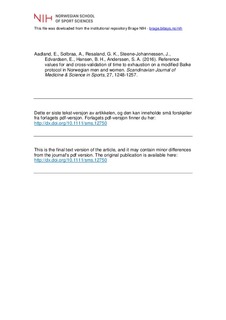| dc.contributor.author | Aadland, Eivind | |
| dc.contributor.author | Solbraa, Ane | |
| dc.contributor.author | Resaland, Geir Kåre | |
| dc.contributor.author | Steene-Johannessen, Jostein | |
| dc.contributor.author | Edvardsen, Elisabeth | |
| dc.contributor.author | Hansen, Bjørge Herman | |
| dc.contributor.author | Anderssen, Sigmund Alfred | |
| dc.date.accessioned | 2018-10-18T12:30:52Z | |
| dc.date.available | 2018-10-18T12:30:52Z | |
| dc.date.created | 2017-01-17T13:10:25Z | |
| dc.date.issued | 2017 | |
| dc.identifier.citation | Scandinavian Journal of Medicine & Science in Sports. 2017, 27, 1248-1257. | nb_NO |
| dc.identifier.issn | 0905-7188 | |
| dc.identifier.uri | http://hdl.handle.net/11250/2568679 | |
| dc.description | I Brage finner du siste tekst-versjon av artikkelen, og den kan inneholde ubetydelige forskjeller fra forlagets pdf-versjon. Forlagets pdf-versjon finner du på onlinelibrary.wiley.com / In Brage you'll find the final text version of the article, and it may contain insignificant differences from the journal's pdf version. The definitive version is available at onlinelibrary.wiley.com | nb_NO |
| dc.description.abstract | Introduction: The aims of the present study were to provide reference values for time to exhaustion (TTE) on a modified Balke treadmill protocol, and to perform a cross-validation of TTE as a measure of maximal oxygen consumption (VO2max), in Norwegian men and women 20 – 85 years of age.
Methods: Reference values for TTE were derived from a national sample of 765 subjects. An additional sample of 119 subjects was included in the cross-validation (total n = 884), where prediction equations for VO2max was established. Results: A decline in TTE was seen with increased age. Prediction of VO2max in an independent dataset (n = 319) resulted in a R2 = 0.78 and standard error of the estimate = 4.55 ml kg-1 min-1. The observed – predicted bias was small (mean difference <1.24 ml kg-1 min-1), whereas random error was considerable (95% limits of agreement ± 7.11 – 9.70 ml kg-1 min-1) across age in both men and women.
Conclusions: Despite limitations concerning the prediction of VO2max on an individual level, TTE from the Balke protocol is a good measure of aerobic fitness in adults across a range of settings, and could be evaluated according to the suggested reference values. | |
| dc.language.iso | eng | nb_NO |
| dc.subject | maximal graded treadmill protocol | nb_NO |
| dc.subject | aerobic capacity | nb_NO |
| dc.subject | vo2max | nb_NO |
| dc.subject | validity | nb_NO |
| dc.title | Reference values for and cross-validation of time to exhaustion on a modified Balke protocol in Norwegian men and women | nb_NO |
| dc.title.alternative | Reference values for and cross-validation of time to exhaustion on a modified Balke protocol in Norwegian men and women | nb_NO |
| dc.type | Journal article | nb_NO |
| dc.type | Peer reviewed | nb_NO |
| dc.description.version | acceptedVersion | nb_NO |
| dc.source.pagenumber | 1248-1257 | nb_NO |
| dc.source.volume | 27 | nb_NO |
| dc.source.journal | Scandinavian Journal of Medicine & Science in Sports | nb_NO |
| dc.source.issue | 11 | nb_NO |
| dc.identifier.doi | 10.1111/sms.12750 | |
| dc.identifier.cristin | 1429704 | |
| dc.description.localcode | Seksjon for idrettsmedisinske fag / Department of Sports Medicine | nb_NO |
| cristin.unitcode | 150,34,0,0 | |
| cristin.unitname | Seksjon for idrettsmedisinske fag | |
| cristin.ispublished | true | |
| cristin.fulltext | postprint | |
| cristin.qualitycode | 2 | |
